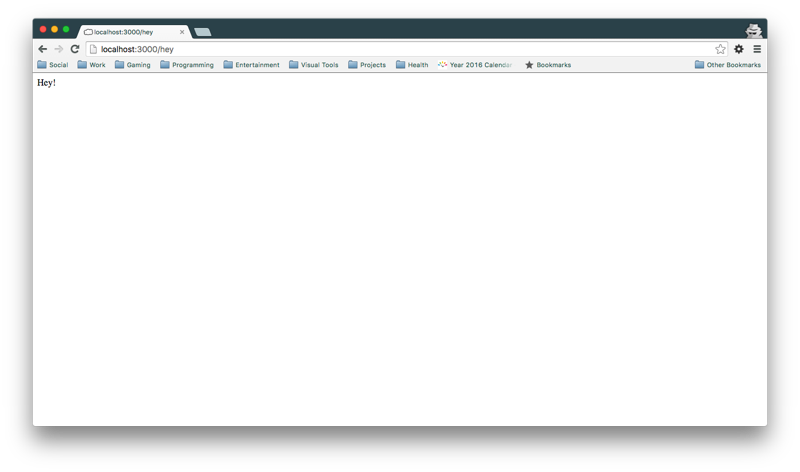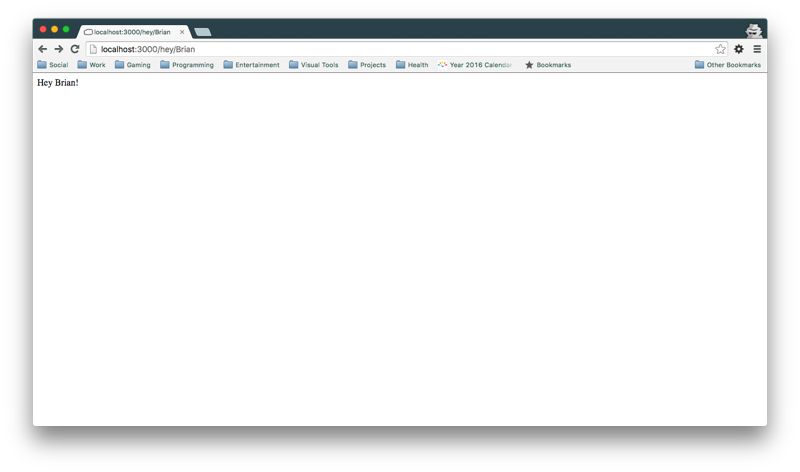The PerlDancer team’s Dancer2 project is a Perl framework for writing Web applications with less boilerplate code than other Web frameworks. I am slowly exploring what it offers. Feel free to follow along.
This is sort of a tutorial. I assume you know Perl and maybe a bit about Web server programming, but not that you have mastered either. My pace may annoy you if you have mastered Perl, Web programming, or Dancer2.
Installation
I use Perl 5.24.0 and cpanm via Perlbrew. Installation of Dancer2 and its dependencies requires a single command.
$ cpanm Dancer2Hey
You do not need much code to create a Dancer2 application.
use Dancer2; # Load Dancer2 and its keywords
get '/hey' => sub { # Define some routes
return 'Hey!';
};
start; # Run the applicationEven better: you can hand this code to Perl and it starts a server!
$ perl hey.pl
>> Dancer2 v0.200002 server 15388 listening on http://0.0.0.0:3000Loading http://localhost:3000/hey in a browser shows our simple message.

Dancer2 gives you a DSL — Domain-Specific Language — to describe your application. These DSL keywords cut down the boilerplate code common in some Web development frameworks.
get
The get keyword defines a route for Dancer2. Routes tell Dancer2 how to respond when someone requests a path — the /hey bit — from your application. get is also a method from HTTP. Use it when you only want to “get” something from the application. Dancer2 has keywords for more HTTP methods, but get is fine for now.
What happens if someone requests a path that you did not define?
Your Dancer2 application returns an error page informing them that the path does not exist.
With the HTTP method and path defined, the last important part of our route is the code. Your application runs that code and sends its return value to the visitor. Our first route code example is an anonymous subroutine that returns the text “Hello!”, but they can be as complicated as you need.
start
start tells Dancer2 that you finished defining your application and it can begin serving to the world.
DSL = Keywords + Sugar
Keywords make the Dancer2 DSL work, but the code style takes advantage of Perl’s flexible syntax. Our route looks like this with less syntactic sugar.
get('/hey', sub { return 'Hey!'; });Hey You
How about greeting the visitor by name? Since form processing involves more steps than I want to think about today, we use route parameters instead.
Dancer2 allows placeholders in route paths. The simplest placeholders are tokens prefixed with a colon, such as :name or :id. When you make a request that matches, such as /hey/brian, Dancer2 saves the matching path part. Here, look at some code.
use Dancer2;
# A simple greeting: /hey
get '/hey' => sub {
return 'Hey!';
};
# A personalized greeting: /hey/Brian
get '/hey/:name' => sub {
my $name = route_parameters->get('name');
return "Hey $name!";
};
start;Route handlers can get much more complicated, but not today. Our application treats a general greeting and a greeting with a distinct name at two different actions, so we use two different routes.
In order to use the new code, we need to stop the Perl process. Control-C should do it. Then launch it again, and the new code will be loaded.
$ perl hey.pl
>> Dancer2 v0.200002 server 31385 listening on http://0.0.0.0:3000Now we should be able to see http://localhost:3000/hey/Brian — or whatever name you prefer.

route_parameters
route_parameters returns a hash-like object which stores tokens and their values from a route match. Use the get method when you need those values in your route code.
Wrap It Up
We installed Dancer2, made just about the simplest Web application I could think of, and explored a little bit about declaring routes.
What’s next? I plan to look at using template files to produce real Web pages.
Backlinks
Got a comment? A question? More of a comment than a question?
Talk to me about this page on:
Added to vault 2024-01-15. Updated on 2024-02-01